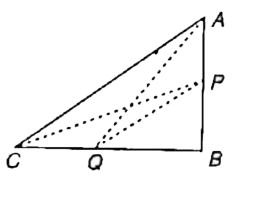ABC is a right angle triangle AB = 3 cm, BC = 4 cm charge +15, +12, -12 esu are placed at A, B and C respectively. The magnitude of the force experienced by the charge at B in dyne is -
125
35
22
0
The correct Answer is:C
To solve the problem, we need to calculate the net force experienced by the charge at point B due to the charges at points A and C in the right triangle ABC.
1. Identify the Charges and Their Positions:
- Charge at A (Q_A) = +15 esu
- Charge at B (Q_B) = +12 esu
- Charge at C (Q_C) = -12 esu
- Distance AB = 3 cm
- Distance BC = 4 cm
2. Calculate the Distance AC using Pythagorean Theorem:
AC=√AB2+BC2=√32+42=√9+16=√25=5 cm
3. Calculate the Force on Charge B due to Charge A (F_AB):
- The formula for the electrostatic force is given by Coulomb's Law:
F=k|Q1Q2|r2
- Here, k=1 in cgs units, Q1=15 esu, Q2=12 esu, and r=3 cm.
FAB=1⋅15⋅1232=1809=20 dyne
- Direction: Since both charges at A and B are positive, the force will be repulsive and directed to the left (negative x-direction).
4. Calculate the Force on Charge B due to Charge C (F_BC):
- Here, Q1=12 esu, Q2=12 esu, and r=4 cm.
FBC=1⋅12⋅1242=14416=9 dyne
- Direction: Since charge B is positive and charge C is negative, the force will be attractive and directed upwards (positive y-direction).
5. Determine the Net Force on Charge B:
- The forces are perpendicular to each other:
→Fnet=FAB^i+FBC^j=−20^i+9^j
6. Calculate the Magnitude of the Net Force:
Fnet=√(−20)2+(9)2=√400+81=√481
- Approximating √481:
√481≈21.93 dyne≈22 dyne
Final Answer:
The magnitude of the force experienced by the charge at B is approximately 22 dyne.
- Charge at A (Q_A) = +15 esu
- Charge at B (Q_B) = +12 esu
- Charge at C (Q_C) = -12 esu
- Distance AB = 3 cm
- Distance BC = 4 cm
AC=√AB2+BC2=√32+42=√9+16=√25=5 cm
- The formula for the electrostatic force is given by Coulomb's Law:
F=k|Q1Q2|r2
- Here, k=1 in cgs units, Q1=15 esu, Q2=12 esu, and r=3 cm.
FAB=1⋅15⋅1232=1809=20 dyne
- Direction: Since both charges at A and B are positive, the force will be repulsive and directed to the left (negative x-direction).
- Here, Q1=12 esu, Q2=12 esu, and r=4 cm.
FBC=1⋅12⋅1242=14416=9 dyne
- Direction: Since charge B is positive and charge C is negative, the force will be attractive and directed upwards (positive y-direction).
- The forces are perpendicular to each other:
→Fnet=FAB^i+FBC^j=−20^i+9^j
Fnet=√(−20)2+(9)2=√400+81=√481
- Approximating √481:
√481≈21.93 dyne≈22 dyne
The magnitude of the force experienced by the charge at B is approximately 22 dyne.
Topper's Solved these Questions
- ELECTROSTATICSBook:MOTIONChapter:ELECTROSTATICSExercise:Exercise - 2 (Objective Problems | NEET)
Explore 64 Videos
- ELECTROSTATICSBook:MOTIONChapter:ELECTROSTATICSExercise:Exercise -3 Section (A)
Explore 41 Videos
- ELECTROSTATICSBook:MOTIONChapter:ELECTROSTATICSExercise:SELF PRACTICE PROBLEM
Explore 27 Videos
- ELECTRONICS - SEMI CONDUCTORBook:MOTIONChapter:ELECTRONICS - SEMI CONDUCTORExercise:EXERCISE - 3
Explore 29 Videos
- ELECTROSTATICS - I Book:MOTIONChapter:ELECTROSTATICS - I Exercise:EXERCISE - 4 (Level -II) PREVIOUS YEAR - JEE ADVANCED
Explore 13 Videos
Similar Questions
ABC is a right angled triangle AB = 3 cm, BC = 5 cm and AC = 4 cm, then the inradius of the circle is :

View SolutionABC is an equilateral triangle of side 10 cm. D is the mid point of BC charge 100 μC,−100μCand75μC are placed at B, C and D respectively. What is the force experienced by a 1μC positive charge placed at A ?
View Solution
Knowledge Check
ABC is a right angled triangle AB = 3 cm, BC = 5 cm and AC = 4 cm, then the inradius of the circle is :
 A1 cmB1.25 cmC1.5 cmDnone of these
A1 cmB1.25 cmC1.5 cmDnone of theseABC is a right angled triangle AB = 3 cm, BC = 5 cm and AC = 4 cm, then the inradius of the circle is :
A1 cmB1.25 cmC1.5 cmD2 cmIn right angled ΔABC,∠B=90∘, if P and Q are points on the sides AB and BC respectively, then :
 AAQ2+CP2=2(AC2+PQ2)BAQ2+CP2=AC2+PQ2C(AQ2+CP2)=12(AC2+PQ2)D(AQ+CP)=12(AC+PQ)
AAQ2+CP2=2(AC2+PQ2)BAQ2+CP2=AC2+PQ2C(AQ2+CP2)=12(AC2+PQ2)D(AQ+CP)=12(AC+PQ)
ABC is a right angled triangle in which AB = 3 cm and BC = 4cm. And ∠ABC=π/2. The three charges +15, + 12 and -20 e.s.u. are placed respectively on A, B and C . The force acting on B is
View SolutionABC is an equilateral triangle of side 10 m and D is the midpoint of BC. Charges of +100C,−100Cand+75C are placed at B, C and D respectively. What is the force experienced by +cC charge placed at point A ?
View SolutionIn right angle triangle ABC, 8 cm, 15 cm and 17 cm are the lengths of AB , BC and CA respectively. Then, find out sin A, cos A and tan A.
View SolutionABC is an equillatreal triangle of each side 5cm. Two charges of ±503×10−3μC are placed at A and B respectively. Calculate magnitude and direction of resultant intensity at C.
View SolutionIn a right triangle ABC,∠B=90 . If AB=14 cm,BC=48 cm, find AC.
View Solution

